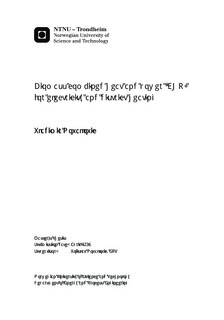| dc.contributor.advisor | Novakovic, Vojislav | nb_NO |
| dc.contributor.author | Novakovic, Vladimir | nb_NO |
| dc.date.accessioned | 2014-12-19T11:51:57Z | |
| dc.date.available | 2014-12-19T11:51:57Z | |
| dc.date.created | 2014-06-18 | nb_NO |
| dc.date.issued | 2014 | nb_NO |
| dc.identifier | 726776 | nb_NO |
| dc.identifier | ntnudaim:10517 | nb_NO |
| dc.identifier.uri | http://hdl.handle.net/11250/235507 | |
| dc.description.abstract | Growing energy consumption requests development of the new energy sources and the application of new technologies in the energy sector. At the same time, the world is facing maybe the biggest challenge in human history global warming. As the energy production sector is the most responsible for the greenhouse gases emissions which cause global warming, new technologies should be capable of decreasing these emissions. Norway energy sector relies on oil and hydro power. More than 95% of Norway s electricity is produced in hydro power plants which puts this country in the world s top when it comes to the share of renewable energy in final consumption. However, most of the electricity comes from large hydro power plants and ends as the heat energy for residential heating due to theundeveloped district heating systems. As residential sector is also responsible for the greenhouse gasses emissions, we come to conclusion that energy system in Norway still needs to be developed. One of the possible solutions is using combined heat and power (CHP) technology which is raising efficiency of the conventional electricity production by using the process waste heat. Waste heat can be used in district heating systems, which can decrease the need for the electricity in heating applications. If carbon neutral fuel, such as biomass is used to power CHP power plant, the problem with greenhouse gas emission could be solved. This paper focuses on designing CHP power plant sized to satisfy heat and electricity needs of Norwegian University of Science and Technology Gløshaugen campus and investigate the possibilities for biomass fuel application."This assignment is realized as a part of the collaborative project Sustainable Energy and Environment in Western Balkans that aims to develop and establish five new internationally recognized MSc study programs for the field of Sustainable Energy and Environment , one at each of the five collaborating universities in three different WB countries. The project is funded through the Norwegian Programme in Higher Education, Research and Development in the Western Balkans, Programme 3: Energy Sector (HERD Energy) for the period 2011-2014." | nb_NO |
| dc.language | eng | nb_NO |
| dc.publisher | Institutt for energi- og prosessteknikk | nb_NO |
| dc.title | Biomass combined heat and power (CHP) for electricity and district heating | nb_NO |
| dc.type | Master thesis | nb_NO |
| dc.source.pagenumber | 46 | nb_NO |
| dc.contributor.department | Norges teknisk-naturvitenskapelige universitet, Fakultet for ingeniørvitenskap og teknologi, Institutt for energi- og prosessteknikk | nb_NO |

